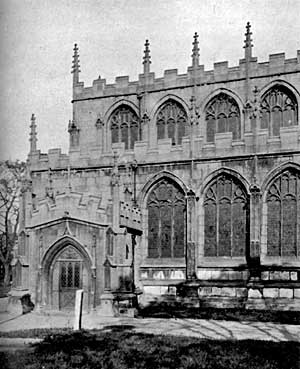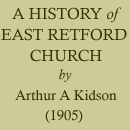< Previous | Contents | Next >

East Retford church – South Porch.
SOUTH PORCH. The outside of this porch is entirely modern, as the whole of the outer stonework was renewed in 1852, before the general restoration. It seems, however, to have been a copy of what previously existed. The inner stonework is original, and the doorway into the Church, judging from its mouldings, may be of the 14th century.
These mouldings are somewhat spoilt by a kind of capital at the springing of the arch, which seems to have been patched on at some later period. The doorway would be much improved if these capitals did not exist.
In medieval times the porch was a much more important part of the church than it is at present, for according to the Sarum use, parts of the baptismal and the marriage services were performed in it. It was also a common meeting place, as may be seen from "Much Ado about Nothing," where the watchman says:—"Let us go and sit here upon the church bench till two, and then all go to bed." The stone seats along the sides of the Retford porch were very possibly used for all these purposes. In ancient times people must have been very much less liable to get rheumatism and lumbago from sitting on cold stone than they are in these more luxurious days.
The little window above the porch door is made up of some interesting bits of ancient glass, which were collected by Mr. Wilmshurst, and were put into their present position when he was churchwarden.
VESICA PISCIS. In the wall of the nave, west of the south porch, is a pointed oval niche formed by the segments of two equal circles. Such a figure is known as a Vesica Piscis (bladder of a fish), and is often used in medieval seals and paintings to surround the person of Our Lord or the Virgin. Here, however, is a statue of a king on a throne, holding a sceptre.
This statue is often said to be the figure of Henry III., but this statement seems to have been originally a wild guess for which there was no foundation whatever. The present statue was carved at the restoration of 1855, in imitation of what the architect believed to be the original condition of the ancient one. But this ancient statue was in a very decayed state. It seemed to be someone sitting on a throne holding the insignia of royalty, and as no case is known of an earthly king being placed in a Vesica Piscis, it probably represented Our Lord in glory. A similar representation of Him is to be found in the tympanum above the Prior's door at Ely Cathedral. In the British Museum is a drawing of the Retford statue made at the beginning of the 19th century. The figure is crowned, otherwise there is no clue as to what it was intended to represent.
The Churchyard forms the angle between Churchgate, or Kirkgate, as it used to be called, and Chapelgate. The name Chapelgate is found frequently in documents of the 14th and 15th centuries, so it must get its name from some ancient chapel, that is a chantry or church to which no parochial duties were attached. Possibly one of the four chantries that were burnt down in 1528 may have been situated here.
After having been used for many hundreds of years as the burying place of the Parish, the churchyard was finally closed in 1854, at which time the cemetery was laid out.
The main part of the churchyard lies south of the Church, as in ancient days there was a prejudice against being buried on the northern side, which was supposed to be the part given up to those who had died excommunicate or unbaptized.
Few tombs of any interest are to be found, and most of the inscriptions are almost illegible. Near the south porch is a sarcophagus-shaped monument to Robert Lightfoot Hewitt, who died in 1847, and who was a member of a well-known Retford family. On one side of the tomb is an inscription in memory of his Mother, Jane Hewitt, who died in 1801. This Jane Lightfoot, as she was called before marriage, was the sister of the beautiful Quakeress, who was said to have been the morganatic wife of George III.
South of the chancel is a granite block in memory of Francis Thornhaugh Foljambe, who died in 1847. Carved out of the granite, is one of the very fewcrosses to be found in the churchyard, and along one side of the tomb are the words: "The Lord grant unto him that he may find mercy of the Lord in that day." Mr. Foljambe was a partner in the bank of Sir Wm. Cook & Co., now known as Beckett's Bank. He lived in the town, and took an active and valuable share in its government. Many strange names are to be found in the registers, but the only one worth mentioning to be found in the churchyard is Camomile, which belonged to William Camomile Briggs, who died in 1842, and who lies buried close to Chapelgate.
There are a few graves north of the chancel, but none north of the nave. Till 1895, all this part of the churchyard was completely blocked by cottages and other buildings, which in one place came up to within twelve feet of the aisle wall. Now all these are taken away, and the land on which they stood has been added to the churchyard. This has been a great improvement to the appearance of the Church, especially as seen from Churchgate.
North-east of the churchyard is the Parish room, which was built in 1887. This room, or rather rooms, for there are two, together with the land which lies between them and the beck, are held in trust for the Vicar and Churchwardens by the Southwell Diocesan Finance Association.
THE VICARAGE. The word Vicarage originally denoted the benefice belonging to a vicar, and though it still keeps this more technical meaning, it now usually denotes, in popular language, the vicar's residence. The earliest notice of such a residence for East Retford is in a Terrier which was drawn up in 1687. This Terrier, which is a document containing an account of the lands and tithes belonging to the Church, mentions a house containing "three bays of building," which means three rooms. It also mentions a "layth containing two bays," which was probably a kind of barn containing two divisions Fiercy states that the house was thatched, of only one storey and very undesirable to live in. He says it was last inhabited by the Rev. W. Wintringham, who died in 1701. The Rev. T. Gylby, who then became vicar had already been Rector of West Retford since 1678, and continued to hold the two livings till his death in 1751. During this time he resided at West Retford, so that the East Retford Vicarage gradually fell into a ruinous condition. When the Rev. R. Morton was appointed Vicar in 1772, he stipulated that a new house should be built, so that in the following year the building which is now usually known as the old vicarage was erected, partly by subscription and partly by a church rate.
In what is now part of the vicarage garden, and facing Chapelgate, was the old Grammar School, which was built in 1779 on the site of an older schoolroom. In 1797 a house for the Head Master was built adjoining it. After the present Grammar School was opened in 1857, the old one was bought by the church authorities and the land on which it stood was added to the vicarage grounds. A few years later, the old vicarage, which abutted on Chapelgate, was pulled down, and the present one, which bears the date 1863, was erected in its place during the Vicariate of the Rev. Arthur Brook.
